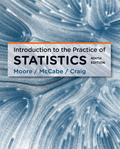
Concept explainers
(a)
The probability of nonoccurrence of event A
(a)
Answer to Problem 18E
Solution: The probability of complementary event of
Explanation of Solution
So
So, the probability that
(b)
To find: The probability that all four tosses result in the same outcome.
(b)
Answer to Problem 18E
Solution: The probability of obtaining similar outcomes is 0.125, and is obtained by the help of
Explanation of Solution
Calculation:
If a coin is tossed 4 times, then there are a total of
So
(c)
To find: The probability of obtaining at least one head and at least one tail.
(c)
Answer to Problem 18E
Solution: The probability of at least one head and at least one tail is 0.875 and is obtained by complement rule of probability.
Explanation of Solution
Calculation:
The events favorable to getting at least 1 head and at least one tail is
The probability is obtained as
(d)
To find: If the events
(d)
Answer to Problem 18E
Solution: The provided events are not disjoint and the property of the probability theory that probability can never exceed one is used.
Explanation of Solution
Calculation:
The probability of events
Now, by the addition theorem of probability
If events
So
Since the probability of any event can never be more than 1, hence
(e)
If the probability of an event A can be −0.04.
(e)
Answer to Problem 18E
Solution: The provided scenario is not possible and the property of the probability theory that the probability can never be less than 0 is used.
Explanation of Solution
Want to see more full solutions like this?
Chapter 4 Solutions
EBK INTRODUCTION TO THE PRACTICE OF STA
- Business Discussarrow_forwardThe following data represent total ventilation measured in liters of air per minute per square meter of body area for two independent (and randomly chosen) samples. Analyze these data using the appropriate non-parametric hypothesis testarrow_forwardeach column represents before & after measurements on the same individual. Analyze with the appropriate non-parametric hypothesis test for a paired design.arrow_forward
- Should you be confident in applying your regression equation to estimate the heart rate of a python at 35°C? Why or why not?arrow_forwardGiven your fitted regression line, what would be the residual for snake #5 (10 C)?arrow_forwardCalculate the 95% confidence interval around your estimate of r using Fisher’s z-transformation. In your final answer, make sure to back-transform to the original units.arrow_forward
 MATLAB: An Introduction with ApplicationsStatisticsISBN:9781119256830Author:Amos GilatPublisher:John Wiley & Sons Inc
MATLAB: An Introduction with ApplicationsStatisticsISBN:9781119256830Author:Amos GilatPublisher:John Wiley & Sons Inc Probability and Statistics for Engineering and th...StatisticsISBN:9781305251809Author:Jay L. DevorePublisher:Cengage Learning
Probability and Statistics for Engineering and th...StatisticsISBN:9781305251809Author:Jay L. DevorePublisher:Cengage Learning Statistics for The Behavioral Sciences (MindTap C...StatisticsISBN:9781305504912Author:Frederick J Gravetter, Larry B. WallnauPublisher:Cengage Learning
Statistics for The Behavioral Sciences (MindTap C...StatisticsISBN:9781305504912Author:Frederick J Gravetter, Larry B. WallnauPublisher:Cengage Learning Elementary Statistics: Picturing the World (7th E...StatisticsISBN:9780134683416Author:Ron Larson, Betsy FarberPublisher:PEARSON
Elementary Statistics: Picturing the World (7th E...StatisticsISBN:9780134683416Author:Ron Larson, Betsy FarberPublisher:PEARSON The Basic Practice of StatisticsStatisticsISBN:9781319042578Author:David S. Moore, William I. Notz, Michael A. FlignerPublisher:W. H. Freeman
The Basic Practice of StatisticsStatisticsISBN:9781319042578Author:David S. Moore, William I. Notz, Michael A. FlignerPublisher:W. H. Freeman Introduction to the Practice of StatisticsStatisticsISBN:9781319013387Author:David S. Moore, George P. McCabe, Bruce A. CraigPublisher:W. H. Freeman
Introduction to the Practice of StatisticsStatisticsISBN:9781319013387Author:David S. Moore, George P. McCabe, Bruce A. CraigPublisher:W. H. Freeman





